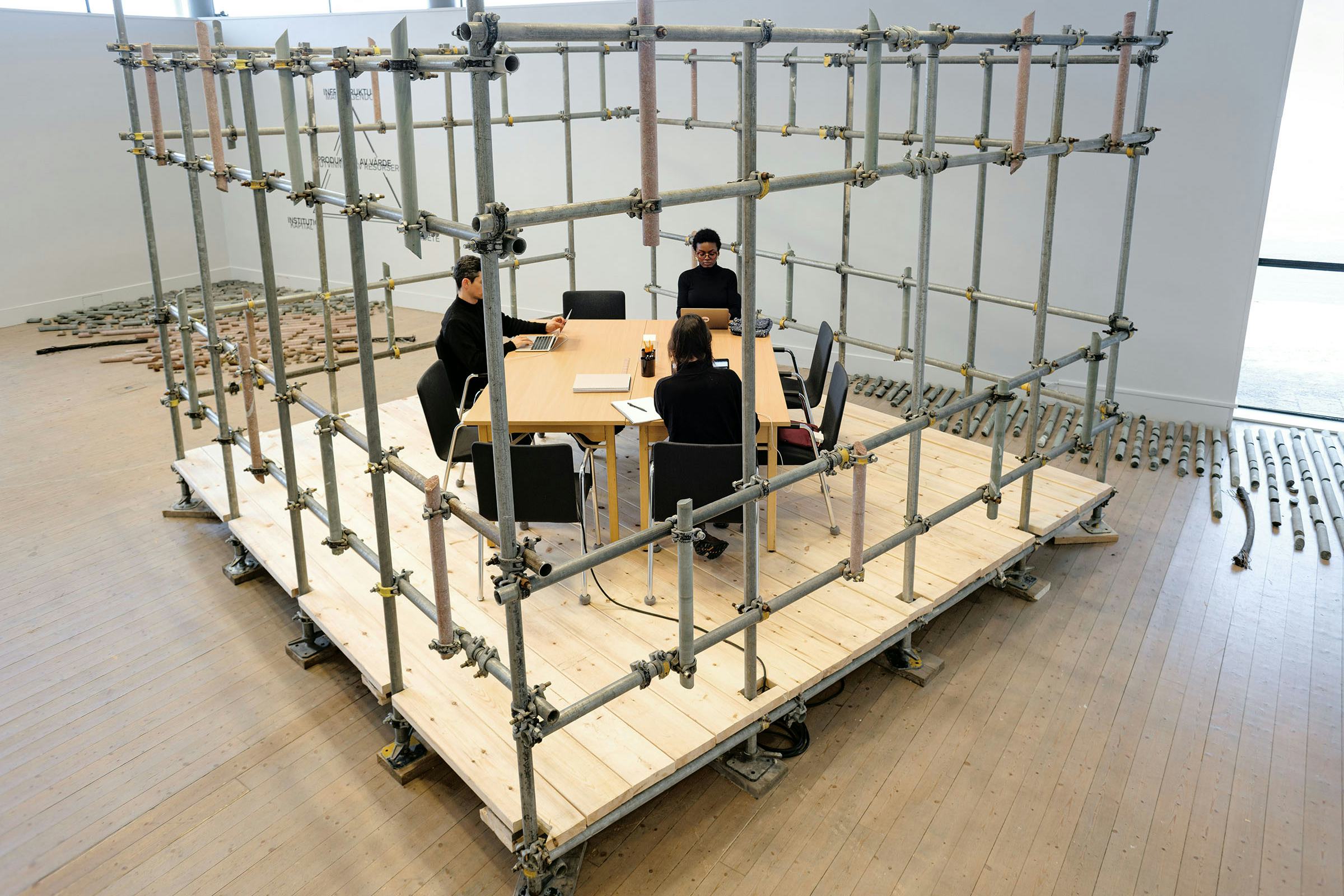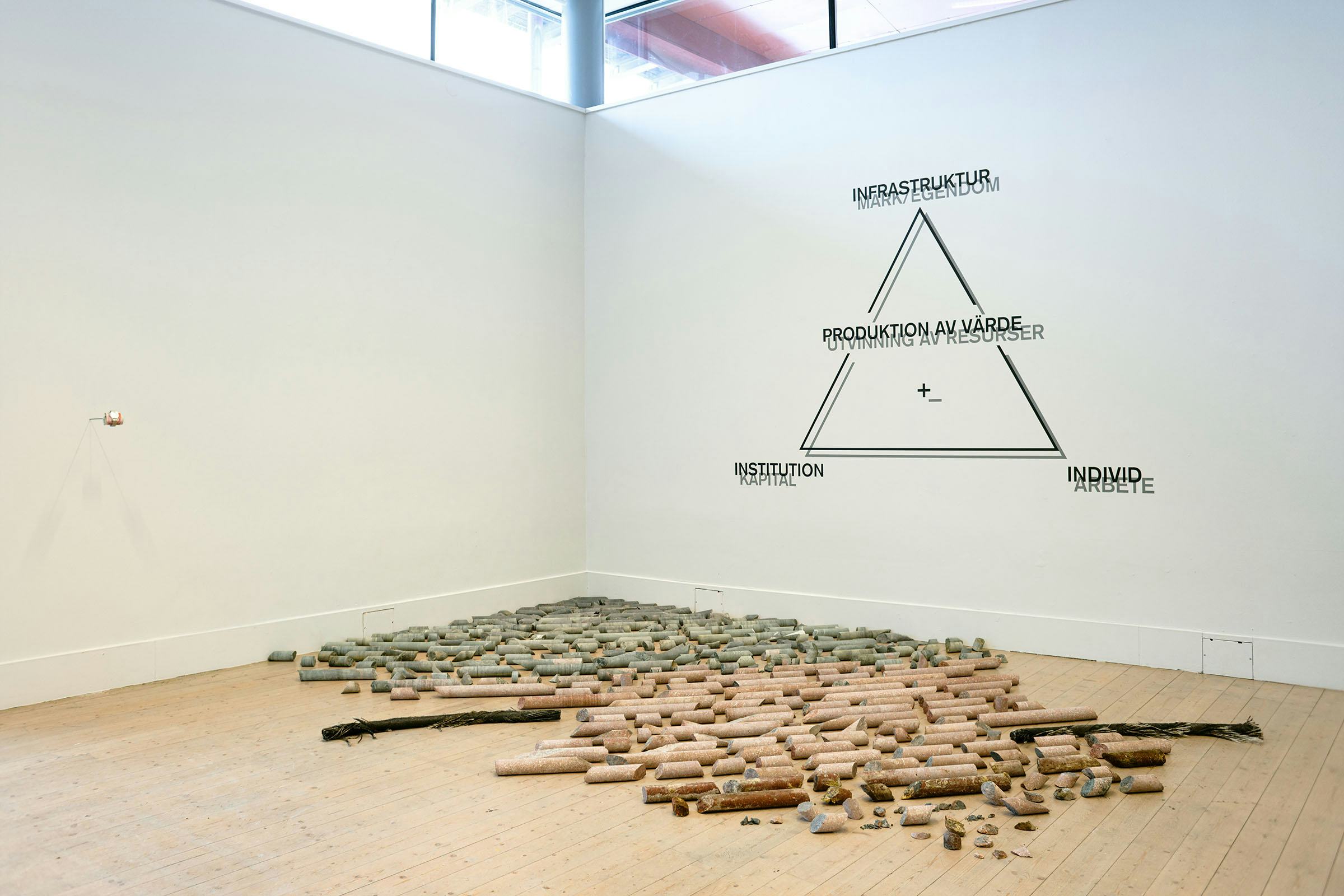LB°24 — Participants
The multiple propositions of Daniel de Paula (b. 1987, Brazilian) reflect upon the production of space as the reproduction of dominant abstract ideologies such as capital, property, labor, and value.
Through a posture that is not constrained to the artistic field, his practice is intersected by notions of human and physical geography, revealing his interest in understanding the complex social, political, economic, and historical forces concealed within our surrounding material reality.
On view in Konsthallen Kulturens Hus, Luleå
form, 2017 – ongoing
negotiation; rock cores resulting from geotechnical surveys carried out in Norrbotten for the assessment of mineral deposits, scaffolding, displacement of the institution’s office furniture to the exhibition space, workforce of Konsthallen Kulturens Hus, sections of the SEA-ME-WE3 telecommunications’ cable
The scaffolding in the exhibition space is a context-specific work by Daniel de Paula titled form, and creates a temporary working space for the staff of Luleå Konsthall. This space, equivalent in area to the two offices where the team normally works, will be utilised for staff meetings and gatherings with the public during the exhibition period. By bringing the processes of institutional conversation and decision-making into the public limelight, the installation not only transforms the exhibition space into a functional working area but also blurs the boundaries between private spaces of decision-making and those intended for public presentation.
In addition to the standard components of the scaffolding, the artist incorporates rock cylinders into the structure, known as drill core samples. These types of rock samples are commonly extracted from the Earth's subsurface through geotechnical drillings to analyse the geological characteristics of a certain area. The pieces consist of layers of rock sedimented over millennia, containing valuable information on mineral composition and geological processes. The exhibited core samples were extracted in Norrbotten to assess the feasibility and profitability of future copper mining in the region.
Copper has a multifaceted importance in today’s society, as its conductivity makes it indispensable for many electrical components and renewable energy technologies. It is one of the essential components of data cables, one of today’s most important technological infrastructures. The work form includes sections of the SEA-ME-WE3 telecommunications cable, the world's longest at a length of 39,000 kilometres, linking North Germany to Australia and Japan. Cables such as this have an increasingly significant impact in Norrbotten, as the region is emerging as a vital hub for data centres. Norrbotten's favourable conditions, including a cold climate and abundant, affordable renewable energy sources, make it an attractive destination for data centre operators, with companies like Facebook already established in the region.
Both the rock core samples and the data cables are transmitters of information, the first holding tangible records of the Earth's geological history, and the latter facilitating the global communication and exchange of data. Both also open potential avenues for resource extraction, from tangible mineral resources to immaterial data. The displacement of the institution’s workforce to the exhibition space and their direct coexistence with these elements, emphasise the interconnectedness of (art) institutions with these and other external world-shaping processes. This invites a reflection on the relations between tangible and immaterial processes, between geological processes spanning millennia, the global flow of data optimised in seconds, and the rhythms of our daily work and lives, unfolding within the human life-span.
PRODUCTION OF VALUE / EXTRACTION OF RESOURCES (from the series anti-epifania), 2024
negotiation; liquitex acrylic and corpse scent utilised for training dogs for the detection of bodies by emergency teams in contexts of infrastructural disasters on museum wall
abstract time, 2019 – on-going
dead worker’s wristwatch functioning counter-clockwise and cash equivalent to monthly minimum wage of a miner in Sweden. 6,5 × 4 × 33 cm
In correlation to the installation intertwining scaffolding, rock core samples, data cables and institutional labour, Daniel de Paula presents an adapted version of his work abstract-time and the wall painting PRODUCTION OF VALUE / EXTRACTION OF RESOURCES.
The work abstract-time consists of a wristwatch which belonged to a deceased mine-worker. The artist altered the movement of its pointers making them run counter-clockwise, while its wristband holds an amount of cash equivalent to the monthly minimum wage of a miner in the region.
The wall painting presents a diagrammatic and textual correlation between the concepts of individual, institution, and infrastructure. Here the painted words and their respective shadows create dissonances of meaning. The paint utilised by the artist is infused with the scent of dead bodies, commonly used in the training of dogs for the detection of corpses in contexts of infrastructural disasters. This subtle scent is known to be perceptible to certain animals but undetectable to the human nose.
These two works expand the artists’ reflection on the connections between the concepts of “time” and “work”, ranging from human life-span to geological eras, and from individual labour to wider structures of capitalism. As well as their connections to institutional and individual agency towards wider world-shaping processes, such as resource extraction and circulation. They also resonate with combustion / production, a new site-specific artwork the artist developed in the town of Kiruna. combustion / production consists of a pavement stone composed of three distinct metals. Part of them come from the world's largest iron ore mine in Kiruna, operated by LKAB, a Swedish state-owned mining company. The other metal comes from the clock pointers of the clock tower of Kiruna’s first City Hall, which has been displaced and installed in the town’s new city centre. The third material is recovered metal from the process of cremation of corpses in Swedish crematoriums, recuperated and recycled by companies that reintroduce them in market circulation, generating profits that are directed to the Swedish pension system. The three different metals are melted and cast into a pavement stone that will be installed in Kiruna’s public space during the closing of Luleåbiennalen 2024 and inhabit the new city centre for posterity.
Daniel de Paula holds a BFA in visual art from Fundação Armando Alvares Penteado in São Paulo and also studied astrophysics and human geography. The artist and researcher has had solo exhibitions at Galeria Jaqueline Martins, BR (2023), LABOR Gallery, MX (2023), Galleria Francesca Minini, IT (2020), and Kunsthal Gent, BE (2019), and took part in group exhibitions such as the Biennale de Lyon, FR, São Paulo Bienal, BR, The Renaissance Society, and Padiglione d’Arte Contemporanea, IT.
Supported by
The European Union
Leader Tornedalen
The Swedish Board of Agriculture
Mondriaan Fund
JIAB Ställningsmontage
SSAB
Oceanic Environmental Cables GmHb.

